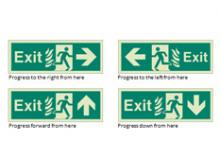NHS Estates – 20 Years Ahead In Fire Safety Sign Design Requirements
NHS Estates - 20 Years Ahead In Fire Safety Sign Design Requirements
Research and the development of the Health Technical Memorandum 65 Part 2 – Fire Safety Signs, which has been superseded by NHS Wayfinding Document, has stood as a bed rock for the subsequent development by both British Standards and International Standards of comprehension testing and inclusion of all graphical symbols for safety application.
The development of ISO 9186-1: 2007 Graphical Symbols – Test Methods – Part 1: Methods for Testing Comprehensibility, is a testimony for the need to ensure not only the extent of comprehension but also gives indication of the need for supplementary text, training and instruction. The graphical symbol chosen by the NHS enhances the British and International Standard symbol with the use of flames as a determinant, presenting a clear and unequivocal message. Research and tests proved that the NHS symbol (see fig 2), increased comprehension and understanding of signs by an amazing 300%.
The legislative framework derived from EC Directive 92/58 requires that responsible persons ensure that all building occupants, not only comprehend the meaning of the safety signs, but also understand the action to be taken in conjunction with the signs.
This certainly was not the case with the following:
Looking at both, it is hard to believe that the first sign is more common place than the escape sign that conforms to NHS Estate requirements. The changes in fire safety legislation moving from a very prescriptive regime to a risk based engineered solution has highlighted the dangers when using escape route signs that may cause confusion. It has taken 20 years for the rest of the industry to question the validity of using a graphical symbol that is not clearly understood.
Using signage that is not clear may have an impact on egress speed and efficient evacuation, which could be fatal. The use of HTM 65 (NHS Wayfinding Document)
for escape route signs ensured that a known convention was implemented for safety way guidance.
This simple convention was a foundation to BS5499 Part 4 2000 and carried its provenance through to the development internationally of ISO I6069: 2004 – Graphical Symbols – Safety Signs – Safety Way Guidance Systems (SWGS).
The understanding of the meaning and actions to be taken in conjunction with safety signs is a fundamental requirement of the Health and Safety (Safety Signs and Signals) Regulations. NHS Estates have to be congratulated for their insight 20 years ago
The NHS Estates will now wait for the rest of the world to catch up and stop playing ‘Pictionary’ with peoples lives.
Means of Escape Publication, on behalf of the Health and Safety Sign Association (HSSA). www.hssa.co.uk
References:
BS 5499-1 : 2002 – Graphical symbols and signs – Safety signs including fire safety signs – Part 1 : Specification for geometric shape, colour and layout
BS 5499-4 : 2000 – Safety signs, including fire safety signs – Part 4 : Code of practice for escape route signing
BS 5499-10 : 2006 – Safety signs, including fire safety signs – Part 10 : Code of practice for the use of safety signs, including fire safety signs
BS ISO 16069 : 2004 – Graphical symbols and signs – Safety signs – Safety wayguidance systems (SWGS)
ISO 7010 : 2003 – Graphical symbols – Safety colours and safety signs – Safety signs used in workplace and public areas.
ISO 9186 : 2001 – Graphical symbols. Test methods for judged comprehensibility and for comprehension.
ISO 3864-1 : 2002 – Safety colours and safety signs – Part 1 safety signs in workplaces and public areas.
ISO 3864-4 : 2009 – Graphical symbols – Safety colours and safety signs – Part 4 colorimetric and photometric properties of safety sign materials.
EC Safety Signs Directive (92/58/EEC).

